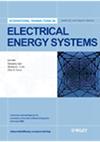S. Jeyadevi, S. Baskar, M. Iruthayarajan
{"title":"基于协方差矩阵自适应进化策略的电压稳定性增强无功规划","authors":"S. Jeyadevi, S. Baskar, M. Iruthayarajan","doi":"10.1002/ETEP.500","DOIUrl":null,"url":null,"abstract":"This paper presents the application of Covariance matrix adapted evolution strategy (CMAES) to reactive power planning (RPP) problem by minimizing the combined total cost of energy loss and the allocation cost of additional reactive power sources. Voltage stability index (L-index) is considered as an additional constraint in order to include the system stability into account. To improve the search efficiency of CMAES, penalty parameter-less scheme is employed for constraint handling. To determine the performance of the CMAES method on reactive power planning problem, IEEE-30 bus test system and Tamil Nadu Electricity Board (TNEB)-69 bus system (a practical system in India) are taken. For comparison purposes, the results of real-coded GA (RGA), particle swarm optimization (PSO), sequential quadratic programming (SQP), and Broyden–Fletcher–Goldfarb–Shanno (BFGS) methods are considered. The simulation results reveal that the CMAES algorithm performs better in terms of energy cost, investment cost, and consistency in getting optimal solution. Karush–Kuhn–Tucker (KKT) conditions are also applied on the best solution obtained using CMAES algorithm to substantiate a claim on optimality. Copyright © 2010 John Wiley & Sons, Ltd.","PeriodicalId":50474,"journal":{"name":"European Transactions on Electrical Power","volume":"21 1","pages":"1343-1360"},"PeriodicalIF":0.0000,"publicationDate":"2011-04-01","publicationTypes":"Journal Article","fieldsOfStudy":null,"isOpenAccess":false,"openAccessPdf":"https://sci-hub-pdf.com/10.1002/ETEP.500","citationCount":"14","resultStr":"{\"title\":\"Reactive power planning with voltage stability enhancement using covariance matrix adapted evolution strategy\",\"authors\":\"S. Jeyadevi, S. Baskar, M. Iruthayarajan\",\"doi\":\"10.1002/ETEP.500\",\"DOIUrl\":null,\"url\":null,\"abstract\":\"This paper presents the application of Covariance matrix adapted evolution strategy (CMAES) to reactive power planning (RPP) problem by minimizing the combined total cost of energy loss and the allocation cost of additional reactive power sources. Voltage stability index (L-index) is considered as an additional constraint in order to include the system stability into account. To improve the search efficiency of CMAES, penalty parameter-less scheme is employed for constraint handling. To determine the performance of the CMAES method on reactive power planning problem, IEEE-30 bus test system and Tamil Nadu Electricity Board (TNEB)-69 bus system (a practical system in India) are taken. For comparison purposes, the results of real-coded GA (RGA), particle swarm optimization (PSO), sequential quadratic programming (SQP), and Broyden–Fletcher–Goldfarb–Shanno (BFGS) methods are considered. The simulation results reveal that the CMAES algorithm performs better in terms of energy cost, investment cost, and consistency in getting optimal solution. Karush–Kuhn–Tucker (KKT) conditions are also applied on the best solution obtained using CMAES algorithm to substantiate a claim on optimality. Copyright © 2010 John Wiley & Sons, Ltd.\",\"PeriodicalId\":50474,\"journal\":{\"name\":\"European Transactions on Electrical Power\",\"volume\":\"21 1\",\"pages\":\"1343-1360\"},\"PeriodicalIF\":0.0000,\"publicationDate\":\"2011-04-01\",\"publicationTypes\":\"Journal Article\",\"fieldsOfStudy\":null,\"isOpenAccess\":false,\"openAccessPdf\":\"https://sci-hub-pdf.com/10.1002/ETEP.500\",\"citationCount\":\"14\",\"resultStr\":null,\"platform\":\"Semanticscholar\",\"paperid\":null,\"PeriodicalName\":\"European Transactions on Electrical Power\",\"FirstCategoryId\":\"1085\",\"ListUrlMain\":\"https://doi.org/10.1002/ETEP.500\",\"RegionNum\":0,\"RegionCategory\":null,\"ArticlePicture\":[],\"TitleCN\":null,\"AbstractTextCN\":null,\"PMCID\":null,\"EPubDate\":\"\",\"PubModel\":\"\",\"JCR\":\"\",\"JCRName\":\"\",\"Score\":null,\"Total\":0}","platform":"Semanticscholar","paperid":null,"PeriodicalName":"European Transactions on Electrical Power","FirstCategoryId":"1085","ListUrlMain":"https://doi.org/10.1002/ETEP.500","RegionNum":0,"RegionCategory":null,"ArticlePicture":[],"TitleCN":null,"AbstractTextCN":null,"PMCID":null,"EPubDate":"","PubModel":"","JCR":"","JCRName":"","Score":null,"Total":0}
引用次数: 14
Reactive power planning with voltage stability enhancement using covariance matrix adapted evolution strategy
This paper presents the application of Covariance matrix adapted evolution strategy (CMAES) to reactive power planning (RPP) problem by minimizing the combined total cost of energy loss and the allocation cost of additional reactive power sources. Voltage stability index (L-index) is considered as an additional constraint in order to include the system stability into account. To improve the search efficiency of CMAES, penalty parameter-less scheme is employed for constraint handling. To determine the performance of the CMAES method on reactive power planning problem, IEEE-30 bus test system and Tamil Nadu Electricity Board (TNEB)-69 bus system (a practical system in India) are taken. For comparison purposes, the results of real-coded GA (RGA), particle swarm optimization (PSO), sequential quadratic programming (SQP), and Broyden–Fletcher–Goldfarb–Shanno (BFGS) methods are considered. The simulation results reveal that the CMAES algorithm performs better in terms of energy cost, investment cost, and consistency in getting optimal solution. Karush–Kuhn–Tucker (KKT) conditions are also applied on the best solution obtained using CMAES algorithm to substantiate a claim on optimality. Copyright © 2010 John Wiley & Sons, Ltd.

 求助内容:
求助内容: 应助结果提醒方式:
应助结果提醒方式:


